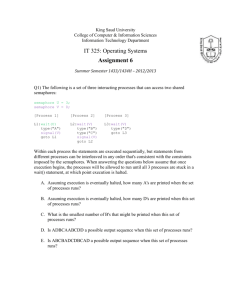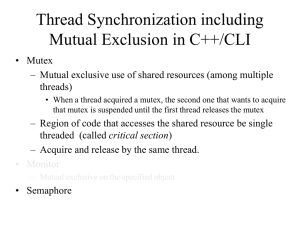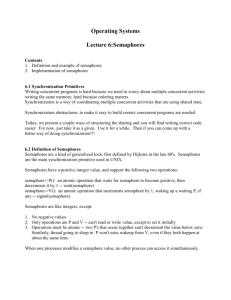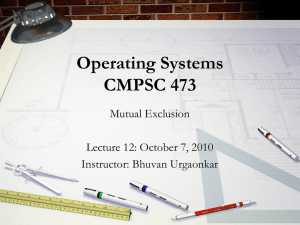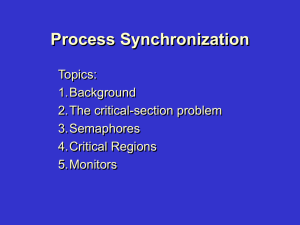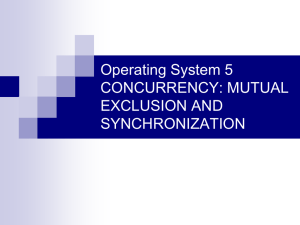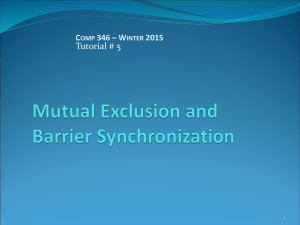pptx
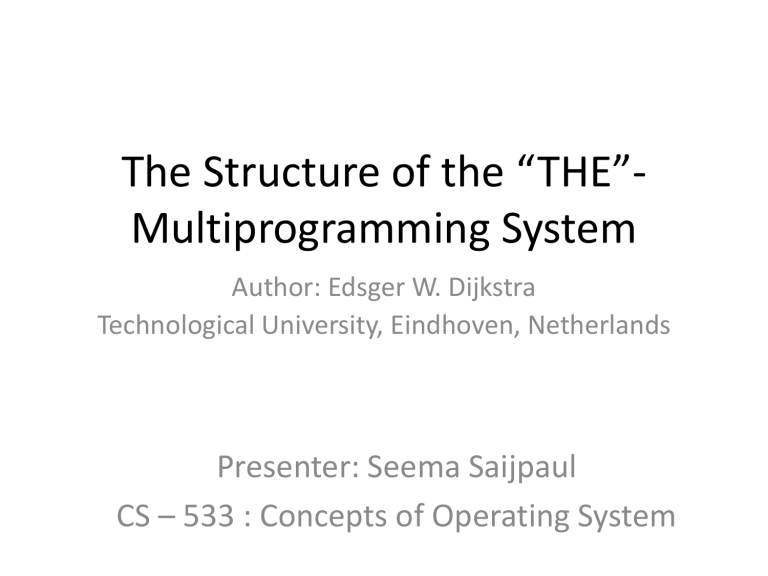
The Structure of the “THE”-
Multiprogramming System
Author: Edsger W. Dijkstra
Technological University, Eindhoven, Netherlands
Presenter: Seema Saijpaul
CS – 533 : Concepts of Operating System
WHY ?
Early Systems
#3
WAITING FOR
THEIR TURN
#2 #1
OPERATOR TAKES 1
PROGRAM
FEEDS IT TO THE
COMPUTER
Computer processes the input
OUTPUT
Operator collects
Output
Problems
• CPU time is expensive. CPU is forced to run at speed of peripheral
• Only one program can run at a time. Long wait for users to get program output
Goal
• Design a system to process continuous flow of user programs
• Design objectives:
– Reduce turnaround-time for short programs
– Economic use of peripherals
– Automatic control of backing store combined with economic use of CPU
– Support applications that only require the flexibility of general purpose processor
Challenges & Solutions
• Ease of System design and validation
– Layered System design
• Resource management among programs
– Abstraction of HW at each layer
• Race conditions
– Semaphores
• Short Response-time
– Priority Scheduling
• Fairness of Scheduling
– Real-time Clock interrupts
HOW ?
Tool
• EL X8 (N.V. Electrologica, Rijswijk)
– Core Memory 32K (=> Present day Main memory)
– Drum 512K words (=> Present day Hard Disk Drive)
– Indirect addressing for stack implementation
– Sound mechanism to handle I/O and interrupts
– Peripherals: Tape readers, punches, Teleprinter …
• System Software:
– OS Programmed in Assembly instructions
– User programs written in ALGOL 60
Processor Allocation
• In a single sequential process, correctness of program is dependent on sequence of event execution
– Speed of execution doesn’t affect correctness
– In THE, whole system is designed as a harmonious society of cooperating sequential processes progressing at undefined speeds
• What constitutes a process in ‘THE’?
– Each user program
– Each input peripheral & Each output peripheral
– Segment controller & message interpreter
• Virtualization of CPU is achieved
– Processes cooperate with each other through mutual synchronization
Semaphores
– Number of cooperating processes is independent of number of actual physical processors in the system
Storage Allocation
• ‘THE’ implements automatic control of secondary storage
• Memory Units: Smallest unit is called Page
– Core Pages: Pages in main memory
– Drum Pages: Pages in drum (hard disk)
• Information unit: Segments (> Level 1 perspective)
– One segment fits in one page (Virtual Page)
– Number of Virtual Pages is much greater than physical pages (core and drum)
Storage Allocation
(cont…)
• Segment identifier contains a segment variable in core
– Segment variable provides the page number where the segment can be found
• Consequences:
– When core page is dumped to drum, the page need not be returned to the same drum page from which it came
• Free drum page with least latency time is selected
– Program pages need not be stored in consecutive drum pages
• Total abstraction of memory locations from programs
– Thus, primitive version of Virtual memory management was achieved
Layer 4
Layer 3
Layer 2
Layer 1
Layer 0
CORE MEMORY (512
WORDS)
DRUM
MEMORY
(512K WORDS)
Storage Allocation
(cont…)
User process requests Memory access;
Provides Segment identifier
Control transferred to Layer 1
Process reads Seg Var to identify page by reading
Core Table Entry.
If Page present in core, segment provided to user program;
Else, “Segment Controller” initiates transfer of page from drum to core.
Drum issues interrupt when transfer is complete.
Segment Controller returns data to program.
Src: http://www.cs.utexas.edu/users/EWD/ewd01xx/EWD113.PDF
System Hierarchy
• ‘THE’ system follows strict hierarchy
• Broken into levels from 0 to 5
• Higher level can talk only to level below
– Communication happens in one direction only
• Advantages:
– Each layer can be validated individually for correctness before implementing next layer
– Abstraction of hardware information from layer above
5
L4
L3
Level 2
Level 1
Level 0
‘THE’ System Structure
Tasks: at this layer
CPU allocation to processes
Allocation of console Keyboard scheduling (Timer ticks)
Priority scheduling for quick
Provides
Provides
LEVEL 5
Synchronization among processes
End- User
Abstraction of memory to higher layers layers
Synchronization
• Processes are synchronized via “Semaphores”
– Semaphore initialized as special integer variables before they can be used by processes
– 2 Operations on semaphores: P (wait) and V (signal)
• It was observed that semaphore was used in 2 ways:
– Mutual exclusion (Semaphore initialized with value 1)
– Private Semaphore (Semaphore initialized with value
0)
Synchronization Behavior
SEMAPHORE
MUTUAL EXCLUSION
PROCESS X
P(Mutex);
// Acquire Semaphore decreases sem count by 1.
If non-negative, then proceed to critical section
PROTECTS
DATA
{
CRITICAL SECTION
}
V(Mutex);
// Release Semaphore increments sem value by 1
PROCESS A
PRIVATE SEMAPHORE
PROCESS B
P(Mutex);
//Acquire Semaphore
{
Inspect & Modify
State variables;
If (true)
V(PrivateSem);
}
V(Mutex);
//Release Semaphore
P(PrivateSem);
//Wait on Private
Semaphore
P(Mutex)
{
}
Modify & Inspect
State variables;
If (true)
V(PrivateSem);
V(Mutex)
SIGNALS WHEN
CONDITION IS
TRUE
Validation
• Two kinds of validation:
– Logical soundness before implementation
• Harmonious Cooperation of processes
– Thorough verification of each layer
• Layer by Layer testing of software
Harmonious co-operation
• Sequential process in the system can be regarded as “cyclic process”
– All processes when at rest are at a neutral point –
“Homing position”
• Harmonious cooperation is proved in 3 stages:
– Process performing task can only generate finite tasks for other processes
• In ‘THE’, higher layer can only generate task for lower layers
– All processes cant be in “homing position” if there is a pending task in system
– After acceptance of initial task, all processes eventually return to homing position.
• “Circular waits” has to be prevented from occurring ;
Else “Deadly Embrace” can result
Software Testing
• Validation of system was done in layers
• Starting at Level 0 , each layer was thoroughly tested
– Next layer is added after previous layer’s been validated completely
– Test structure forces the system into all different relevant states and verified if the system performs according to specification
• Hardware failures couldn’t restrict system validation due to hierarchical design of system
Summary
• Layered OS design helped in abstraction of hardware resources to programs
– Level 0: Abstracted processor
– Level 1: Abstracted Memory through segments
– Level 2: Abstracted console
– Level 3: Abstracted peripherals
• Sequential processes collaborated with each other
“harmoniously” through Synchronization
– Mutual Exclusions and Private Semaphores
• SW memory segmentation achieved optimal use of core and drum memory
THANK YOU!
References
• Wikipedia: http://en.wikipedia.org/wiki/Multiprogr amming && http://en.wikipedia.org/wiki/THE_multiprogrammi ng_system
• Dijkstra : http://www.cs.utexas.edu/users/EWD/ewd01xx/E
WD113.PDF
• Prof. Jonathan Walpole (For his valuable inputs on the paper)
• Navya Jammula : CS 533 , Winter 2008
• Payal Agrawal : CS 533, Spring 2009

